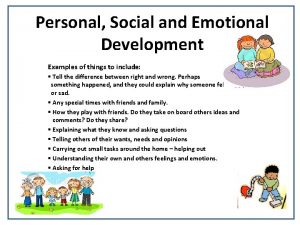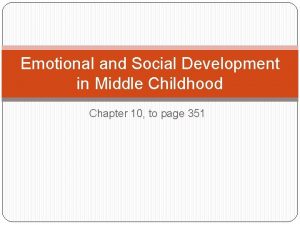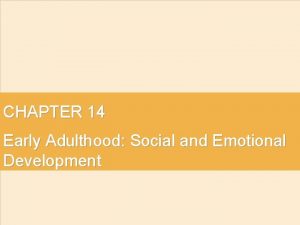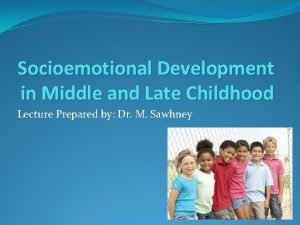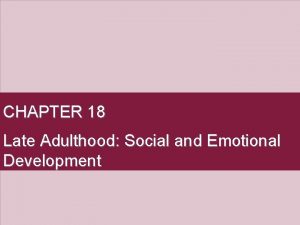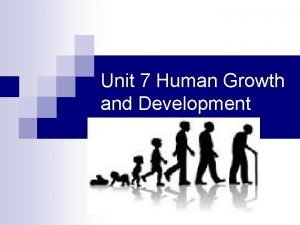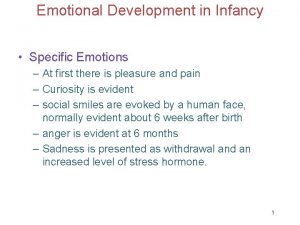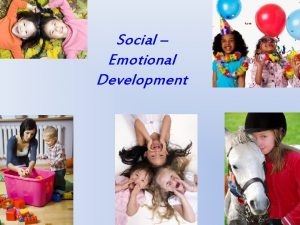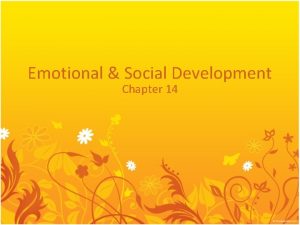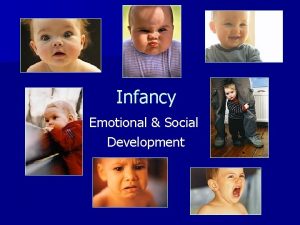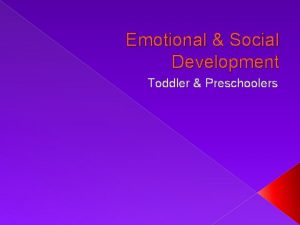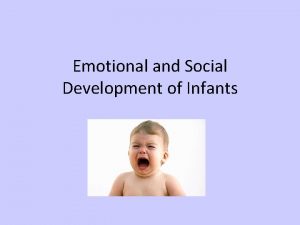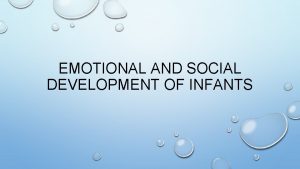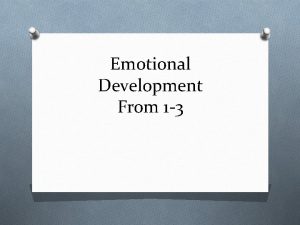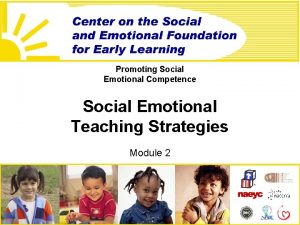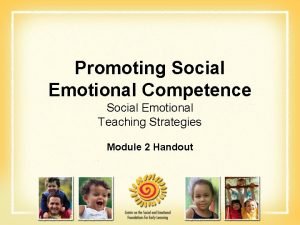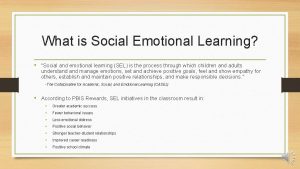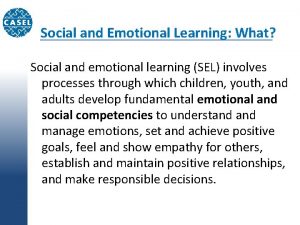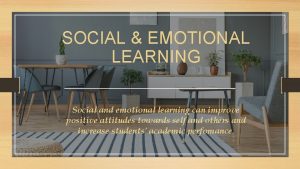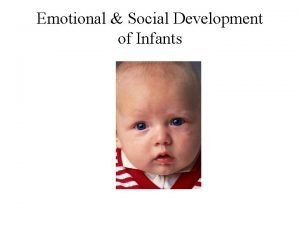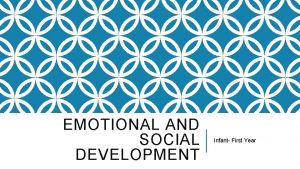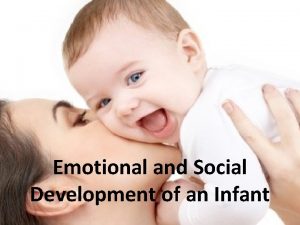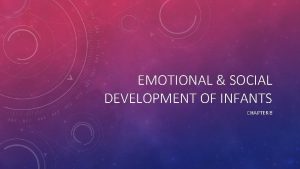Social Emotional Development General Emotional Patterns 4 6






















- Slides: 22

Social – Emotional Development

General Emotional Patterns 4 -6 year olds: Ø Meet new people – can change behaviors Ø More responsibility – greater independence • 4 year olds (negative): (Positive): – Self-centered * Loving and affectionate – Impatient * Want parental approval – Defiant – NO * Like to make people laugh – Bossy * Trying to be independent – “Turn on a dime” – Name-calling, making fun or playing with someone’s name sounds

General Emotional Patterns - continued • 5 year olds (Positive): – Practical -- Serious – Sympathetic --Conscientious – Mindful of parents/teachers --More realistic – Conform to rules easily • (Negative): – Anxious – Can be too eager to please

General Emotional Patterns cont. • 6 year olds (Positive): – Appreciate humor more – Stronger emotions – Crave praise • (Negative): – – – Stubborn Quarrelsome, argumentative Rapidly changing moods, again “Know-it-all”, resent directions Easily hurt and discouraged

Specific Emotions • Self-confidence – when successful child’s confidence improves – Develop INITIATIVE – motivation to do more. • Anger – • At 4: Show physically, lasts longer, may threaten others to “get even” • At 5: Want to hurt feelings of others more than physical hurt. • At 6: Tease, insult, nag, make fun – more wordy

Specific Emotions - continued • Anger – continued – Frequency decreases, but anger lasts longer in this age. – Tolerance for frustration increases a little with age. – May try to punish authority figure for being punished. • How do deal: – Have more social interactions to learn how to handle different situations or practice social situations to prevent angry feelings – Accept that things belong to others, not just themselves Teach respect for others’ belongings – Set an example for how to handle anger appropriately – Encourage use of words to describe feelings rather than the physical expression

Specific Emotions cont. • Fear– – Well-developed imagination – imaginary dangers • Ghosts, robbers, monsters, kidnappers, vampires… – Children may also fear school – afraid to leave security of home/family. – School itself may be a fear - leaving home – Being abandoned by caregiver • How do deal: – Accept the fear – it’s very real for the child, don’t blow it off. – Listen without ridicule – Children won’t trust you if you make them feel badly about the fear. – Face the fear – practice how to handle the situation before it happens. • Pet a toy dog before the real thing • Look under the bed/in the closet in daylight before doing it at night.

Specific Emotions cont. • Jealousy– – Sibling rivalry • Very common • Tattling on sibling • Comparisons are rarely helpful, often hurtful to a child • How do deal: – Don’t compare children at home or in the classroom – Teach empathy – A little extra attention, for each child, separately is good, have a special activity for different children

Stress • Stress is everywhere for every age!!! Learn to look for signs of stress: – – Nail-biting --Trouble sleeping Moodiness --Trouble in school Headaches --Pulling away/Being clingy Any difference in child’s behavioral pattern • Hug, listen, teach/model how to handle stress • Find the cause of the stress • Teach ways to relieve stress • Maintain normal limits on behaviors. --Read a book about stress --Follow up on children

• Good: Competition – Stimulates higher standards – Highlights individual achievement – Gains realistic view of abilities – Helps children excel – Encourages speed • Bad: – Success depends on ability to “out-do” others – Leads to hostile relationships – Results in lack of effort in those who don’t usually win – Points out children’s inadequacies – Lowers status/self-esteem of those to lose

General Emotional Patterns 7 -12 year olds: • Developing a sense of self: – Children develop their personality and know they are unique. – See themselves as a mixture of traits and qualities – Can recognize own skills and abilities. – Realize they behave differently in different situations. – Know that others perceive them differently than they do. Point of view. • Gender Identity: – Differences between being a boy or girl. – Role models. – Interest in opposite sex

Middle Childhood – Emotional Changes • A sense of self: – Beginning to think abstractly – Trying to figure out who they are and will become – Finding out unique characteristics about self – Discovering talents – Seeing different behaviors in different situations, roles and their expectations – Seeing how others perceive them, different points of view

Middle Childhood – Emotional Changes continued • Being male or female: – Gender Identity – what girls/boys do/have – Spend more time with same gender – Desire to behave like others of same gender – Identify ROLE MODELS – Begin exploring relationships with opposite gender

Middle Childhood – Emotional Changes continued • Age 7: withdrawn, quiet, worry-warts sensitive, prefer to be near home • Age 8: more outgoing, want to explore, dramatic, lively, positive view, tend to exaggerate • Age 9: harsh toward self and failing, tense, concentrated • Age 10: positive, happy, enjoying everything

Middle Childhood – Emotional Changes continued • Early Adolescence: – HORMONES!!!!!! Puberty sends hormones into overdrive – Mood swings – look out, they’re quick and intense – Self-absorbed – pay attention to self and peers – Often hide true feelings – seem not to care – Emotional control is developing – somewhat

Middle Childhood – Specific Emotions • Anger: – Boil over and fade quickly – Anger action is usually not reacting to immediate situation, but something prior and peer related – Can use words much better to express problems – Setting a good example is the best way to teach how to handle anger and frustration – Show to handle without violence or physical ration of any kind – Rewards can be appropriate to help train

Middle Childhood – Specific Emotions cont. • Fear & Worry: – Fears still exist, may interfere with sleep – New worries show up, more severe that the dark – car accidents, death • Usually in response to what happens in family or peer group • Concern for how others view them • Still peer focuses – their opinions matter more

Living with children 7 -12 • 4 helpful hints for dealing with children in this age are: 1. Be Patient!! – this is a difficult time, they need to learn how to deal with all the changes. 2. Don’t take it personally – It’s a phase, it will pass, they don’t usually mean what they say. 3. Keep the child under control – Don’t allow for inappropriate behavior, explain what’s appropriate 4. LISTEN – Kids usually want to talk, let them, it doesn’t mean you agree with them, but show to handle it.

Social and Moral Development 712 • Children value friends who are loyal, comfortable, and fun • Puberty affects friendships – kids want to talk to kids • Relate deeper to others – empathy • Tend to keep more friends of the same gender, even though they may be interested in the opposite gender

Social and Moral Development 7 -12 continued • Number of friends varies, no right number • Do you have the friendships you WANT to have? Do you value yourself by the NUMBER of friends you have? • Peer Pressure – adopting words, behaviors, habits of peer group to fit in – Can be VERY powerful, both positively and negatively. – Conformity – adopting words, behaviors, habits of peer group to fit in, avoid ridicule – Joking, teasing – very hurtful, damaging

Social and Moral Development 7 -12 continued • Family relationships change and grow • Family time, rules and boundaries are still needed • Changes in feelings toward parents: – – – 7 s – depend on parents, but challenge parents’ rules 8 s – cling to parents 9 s – self-centered, ignore parents more 10 s – usually smooth-sailing 11/12 s – can be critical, more questioning and development of thought – 12 s – more cooperative – Late teens – usually return to respecting parents, understanding why rules are important

Social and Moral Development 7 -12 continued • Moral Development: Observe morals of others and have to start to decide more for themselves – Set good examples of moral behavior: “Do as I say AND do” – Support a child’s conscious development – “inner Jimminy Cricket” – Discuss possible situations/outcomes include examples for your past, if appropriate – Reinforce and model empathy – how would you feel if that happened to you? ? ? – Fairness matters – use that to explain situations
 Personal, social and emotional development examples
Personal, social and emotional development examples Autonomy vs shame and doubt example
Autonomy vs shame and doubt example Social development in middle childhood
Social development in middle childhood Middle age
Middle age Socioemotional development in early adulthood
Socioemotional development in early adulthood Emotional development in late adulthood
Emotional development in late adulthood Dating serves several important functions that include
Dating serves several important functions that include X videos
X videos Global agenda for social work and social development
Global agenda for social work and social development Apa itu social thinking
Apa itu social thinking Social thinking social influence social relations
Social thinking social influence social relations General responsibility assignment software patterns
General responsibility assignment software patterns Define emotional development.
Define emotional development. Late childhood emotional development
Late childhood emotional development Late childhood
Late childhood Developmental milestones 40-65 years
Developmental milestones 40-65 years Robert peck developmental tasks
Robert peck developmental tasks Social changes in middle adulthood
Social changes in middle adulthood Social changes in late adulthood
Social changes in late adulthood New emotions that appear toward the second year
New emotions that appear toward the second year Chapter 8:1 life stages
Chapter 8:1 life stages What is emotional development
What is emotional development Emotional development in adolescence
Emotional development in adolescence
